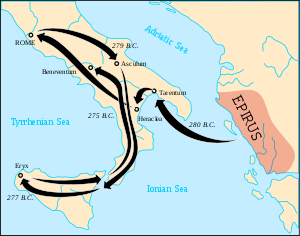 Image via Wikipedia
Image via WikipediaWhen I think of BC, a time before the Gregorian calendar – our calendar – and Christianity came into existence, I think of primitive human beings, as cavemen, or monkeys. The reality is much more than that. Humans of the time were an intelligent start to mankind; creating the foundations for the world we live in today. Romans, who spoke Latin and lived in Rome, Italy, just off the Mediterranean Sea where just one group, and they are the group we are focusing on today. Three great wars over 500 years enabled Romans to control all of Italy.
These wars started with the Samnite war, from 300 to 200 BC, and were followed by the Pyrrhic war and not much later, the Mercenary war. By 100 BC, the small town of Rome controlled all of Italy, and they would not stop expanding until they controlled all of the Mediterranean.
The three Samnite wars lasted from 340 BC to 290 BC. The First Samnite War began in the 340’s while Rome’s army was preoccupied with another Persian war in the east. The Samnite army took this as an invitation to attack outlying colonies in western Italy. The colonies sent for Rome’s help, and a Roman envoy was sent to negotiate a way around the war. However, neither side could agree on the terms, and therefore a war broke out on the Plains of Campania. Rome led the fight from the beginning, and before long they had turned their attentions back to the Persian war. However, not long after, the Samnite Army managed to trap the Roman Army in the mountains, forcing the army to surrender and agree to a five year peace treaty. Embarrassed, Rome took this time to create their first road; a highway for the time. They began the Third Samnite War in 298, but this time they not only faced the Samnites, but their old enemies the Gauls, Umbrians and Etruscans as well. Rome was not used to facing such a large army and struggled to overcome the four groups. After 5 years of fighting around the city Sentinum, the opposing forces were forced to surrender. Samnite would never trouble Rome again, and the two lived peacefully from thereafter.
 Image via Wikipedia
Image via WikipediaThe next year, Rome was part of another battle, but this time they did not engage their recovering cavalry and soldiers. The Mercenary War, which began in 241BC, was a war between the city of Carthage, not yet part of the Roman Empire, and a band of angry, angry mercenaries. The mercenaries, almost twenty thousand strong, were lead by Gesco. They originated from Sicily, and moved into Carthage territory to fight for more pay to fulfill their contracts. Negations were attempted, but ignored as the mercenaries took over Tunis, a small down near Carthage. From there, they convince other small towns to revolt with them, out from Carthage’s command. The Carthage army is lead by Hanno the great, and Hamilcar in 239BC and it is defeated several times by the towns and mercenaries. Seven hundred Carthaginian prisoners are executed, while others forced to join the mercenary army. Hamilcar wins the war for Carthage by cutting of the supply lines to the mercenary army, forcing them to leave. Not long after, Rome declares war on Carthage. They surrender almost immediately, with barely any troops to fight back as in 237 BC, Rome occupies Carthage. Now Rome has power over the entire Italian country, and shows no signs of slowing down.
A great many battles were fought in Rome, around Rome, and within the Roman Empire in it’s thousand-year history. These three wars are three of the hundreds, even thousands, but they are important because they lead to Rome’s control over Italy, the central hub of their many conquests all over the Mediterranean Sea. The Samnite wars lead Rome to control central Italy, the Pyrrhic war opened up the southernmost tip of Italy, while the mercenary war ended with Rome in control of northern Italy, and the island to the west of Italy. The Great Roman Empire would reach out from here to cover all the land around the Mediterranean Sea, but it would never forget the city that began it all; Rome.
I had to gloss over a lot of facts for this speech to be 5 minutes, but I think I did pretty well. I probably have some things messed up, but it's such an interesting topic!
S a r a h

1 comment:
I think its pretty good actually :)
Post a Comment